 |
||
|
||
| ||
Before reading this article we recommend that you take a look at the VIA Eden platform review because we are not going to repeat definitions and basic ideas, and performance will be formulated mostly as advantages of the tested model over the EPIA-5000. Although we can't avoid comparing the old and new versions of the platform, remember that they have a bit different fields of application, that is why the prices should be accounted for in the last turn. While the first line is simply EPIA (Eden Thin Client Platform) and it's meant for simple applications, the EPIA-M series is for tougher computational tasks and, in the first turn, for video. What allows such systems to play video considering that the EPIA-5000 did it awfully? Improved characteristics and capabilitiesToday we are testing the EPIA-M9000:  As before, the box measuring 20x20x10 cm contains the board itself, a user guide in English, a CD with drivers, an e-version of the user guide and a couple of utilities, ATA66/100/133 and FDD cables and a bracket with couples of USB and FireWire ports. 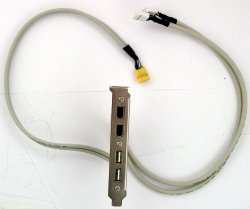 This tidy board of the Mini-ITX format covered with blue varnish: 
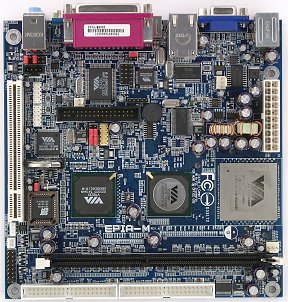 incorporates the VIA C3-E processor (economical version) clocked at 933 MHz (there will be also EPIA-M6000 models with the Eden ESP 6000 processor (667 MHz) that doesn't need active cooling).  This model needs the cooler with a fan; the latter rotates at ~6500 rpm. Although the impeller is quite small and rotates on ball bearings, the noise is clear and unpleasantly acute. The processor is based on the Ezra(-T) core, works at the rated voltage of 1.325 V (lower compared to other usual models) and dissipates about 10 W at most (surely, the 5W ESP 6000 looks much more attractive in this respect). The performance level of the processor can be estimated from the comparison of the VIA C3 1 GHz with modern solutions from AMD and Intel. Although VIA's processors lose to the leaders, they suit some tasks which were defined by us for the 533MHz version in the first review of the VIA Eden. However, if in integer arithmetic we can expect some acceleration, real applications need also fast memory, a video card etc. What can the EPIA-M series offer given to its video orientation? The answer is the VIA CLE266 (VT8623) chipset used for such models which comes with the AGP 8x (?) CastleRock graphics core and VT8235 south bridge. 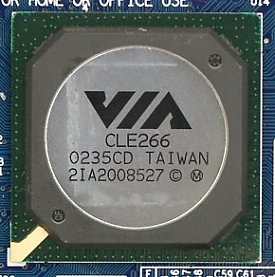
 The chipset, one of rare chipsets for the Socket 370, is designed for DDR memory (up to 2 GB of DDR200/DDR266). If you remember, the EPIA-5000 lacked the bandwidth when pumping huge amounts of data though the memory and working simultaneously with the video chip (in particular, the DVD was played jerkily; the only way out was an external video card). But note that you can't use 2 GB as there is only one slot (for 1 GB module) on the board. At the same time, there are no problems with peripherals thanks to the latest version of the VIA's south bridge - VT8235 which ensures operation of the Fast Ethernet controller (using the external PHY VT6103), 4 ATA133 devices, 6 USB 2.0 ports, 6-channel AC'97-Audio (using an external VT1616 codec) and some other functions common for all modern chipsets. 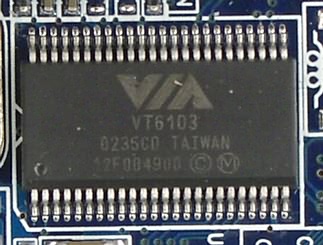
 The board incorporates a floppy disc drive connector: although it's not so necessary these days, it's for you to decide whether you need it or not, contrary to what we could see in the EPIA models. Expandability is limited by one PCI slot which, though, can be turned into two with a special adapter. Above all, the chipset uses a 2-port FireWire (VT6307S) controller and TV-encoder VT1622. 
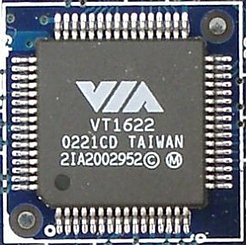 The connectors located on its back are typical; we saw the same lot on the EPIA-5000. The coaxial output next to the S-Video can be switched (with a jumper) to RCA Video or S/PDIF (audio). The six-channel sound comes out through three available connectors; the functions can be set in the drivers.  Video core and TV-OutAn owner of a system with the 933MHz processor (though with the weak FPU) may concern with performance of the built-in 3D accelerator for playing games. Theoretically, the CastleRock core (earlier known as Zoetrope) of 64 bits and one pixel pipeline with two texture units corresponds to video accelerators of 1998-99, i.e. to Voodoo2 or Riva TNT2/Ultra - depending on the core frequency, which is unfortunately not specified. But a real speed in games can't be predicted as we haven't got the OpenGL drivers for it which can tell upon the performance the most unpredictable way. While the gaming performance is not a key characteristic of the EPIA-M, 2D quality is. And the quality was quite good with the 17" Samsung SyncMaster 757 DX monitor in 1024x768x16 and 1280x1024x16 at 85 Hz (maximum). The video core takes a frame buffer of adjustable size (in the BIOS Setup) from 16 to 64 MB from the main memory. Another important feature of an integrated video is full hardware acceleration of MPEG2/DVD playback. At last, TV-Out quality is also very important due to the positioning of the platform. A signal is encoded by the most advanced chip of the VIA's line - VT1622 supporting SDTV, PAL/NTSC standards and a resolution up to 1024x768 inclusive. Video output is driven via S-Video or RCA Video (when the mode of the coaxial output is set with a special jumper). A receiver can be chosen in the BIOS Setup which offers CRT/TV/CRT+TV (the firmware version 1.09 offers only CRT/TV). Here you can also choose a TV standard (PAL/NTSC). Unfortunately, the TV displayed only the POST and the VGA mode of Windows 2000 booting, loosing picture at the desktop-mode in spite of all our experiments with resolutions and refresh rates. This is undoubtedly a disadvantage as potential ability to start Windows and some video player without the monitor could be very useful. To display a picture on the TV screen you have to use monitor and change video output mode in a special tab in the video drivers. Another downside is that the system supports only the clone video mode, though the chipset (due to it's specs) is able to support two different outputs at different refresh rates and resolutions. This is definitely a disadvantage, and, the worst, it may be because of the restricted version of the chipset, not because of the drivers. However, TV quality was very high regardless of the connection type (S-Video or RCA Video). You'll have to spent some time adjusting brightness, colors and other parameters of a TV picture (the parameters are saved automatically) and we were not able to set good enough picture on both receivers - it didn't let us use them simultaneously (due to different geometry of the screens and inacceptable refresh rate at the monitor). But finally the TV excellently played video, and in 1024x768 in the desktop mode it was possible to read the lines of large font and set some video player's options. The artifacts of the MPEG4 compression looked very surprisingly on the TV screen. :) BIOSWhen we tested the EPIA-M9000 board in our lab it had the BIOS 1.02 dated April. By the official announcement VIA made available the ver. 1.09 of November 19 marked as the initial revision. Obviously, this version will be used for the production models; at first glance its only difference is lack of support for simultaneous image displaying on monitor and TV. The 2MB BIOS is based on the classical version - AwardBIOS 6.00 PG of Phoenix and offers the following settings and overclocking features:
One can also distribute interrupts manually and disable any of integrated controllers. The system can boot from the USB-FDD, USB-ZIP, USB-HDD, USB-CDROM and LAN. In the latter case it will use Boot ROM of the onboard network controller, which is convenient, for example, for diskless workstations. As we couldn't find a program for the Windows for correct recognition of the monitoring module of this motherboard, the monitoring of critical system parameters became crucial. It keeps track on a processor's temperature, rotational speed of two fans including the processor's one, and CPU voltages - 3.3, +5 and +12 V. Since we couldn't access these data in the real time mode under the Windows even with the latest versions of all programs including MotherBoard Monitor and SpeedFan, we had to define the CPU's temperature approximately, by rebooting the system (cold restart) and checking up the value in the BIOS Setup. Alas, we didn't have a computer case of the Mini-ITX format or some other good small case, that is why the absolute values of the temperature mode were of little interest. But the figures from 49° to 63°C with a minute heatsink make me think that a big radiator could let us work without a fan (though it could be a problem to mount such a radiator). PerformanceThe tests will help us find out what and how can we do something by the EPIA-M9000. We thus try to estimate adequacy of the model for the same tasks used for the EPIA-5000. But while the previous model could be judged unstrictly in operations beyond the Thin Client Platform conception, the price and positioning of the current model must imply perfect video playback quality (while the EPIA-5000 couldn't handle it). The tests were carried out with 256 MB memory with minimal possible timings under the Windows 2000 Pro + SP3, the disc was formatted under the NTFS, the drivers were VIA 4-in-1 v4.43v, Video v5.13.01.008. Internet client and business class applicationsThese two types of tasks are combined into one - as the EPIA-5000 performed excellently there, we expect the same from the EPIA-M9000. Well, the 933MHz processor copes easily with all of them: browser, graphics and text editors windows, Acrobat Reader etc. were drawn immediately, spelling was checked in the MS Word XP on the fly, the page navigation worked flawlessly... Taking into account the scores of the previous VIA Eden platform, I can say that the EPIA-5000 could be a perfect match for a computer which is not loaded much with work and if little delays are not critical (for example, for an operator). If you need blameless operation, go with the fast processor and fast memory of the M-series. Remember that in this case "operation" mostly means just moving the mouse pointer and pressing keys - not computational load like compilation or rendering! DVD playbackThe architecture of the platform that supports DDR memory must be able to provide normal DVD playback (the EPIA-5000 coped with it when memory of an external video card was used for overlay instead of the shared system memory) at the expense of the increased throughput and memory access. Moreover, the system equipped with a video core with the full hardware acceleration of MPEG2 just can't fail in any way. In the tests we used PowerDVD XP 4.0 Deluxe and InterVideo WinDVD 4 players and a CD with Final Fantasy movie and another one (just to be sure). Well, in any video mode using any audiotrack the movies were played smoothly, without any delays. Note that the DVD quality on the TV screen was superb. Playback of MPEG4-videoHere we used two fast freeware players: BSplayer 0.85 and Zoom Player 2.90,
and two decoders: DivX 5.02 and ffdshow (hoping to use the optimization
of the latter for the 3DNow! instructions supported by the C3 processor).
The test movies were The Matrix of a low bitrate (80 KB/s video + 16 KB/s
MP3 sound; 25 fps) and the second part of the Indiana Jones and the Last
Crusade of a high bitrate (196 KB/s video + 12 KB/s MP3 sound; 30
fps). As the requirements are now higher (video playback is not just add-on
but an obligatory requirement), we changed the testing technique: we recorded
the maximum decoding quality level when a random still scene and a random
dynamic scene (the building assault by Neo and Trinity in the Matrix,
and the chase at the beginning of the second part of the Indiana Jones)
were played without jerking. As the ffdshow decoder automatically controls
the postprocessing level and omits some frames itself when the processor doesn't
cope with decoding, the only aspect to study in case of the ffdshow can be playback
quality (including slowdown and lost frames). The results are given
in the table where the "effects" stand for the respective settings (Film
Effects) of the DivX decoder:
So, on the EPIA-M9000 platform it's possible to watch almost any MPEG4 movies at the highest quality if a player and decoder (and the parameters) are chosen correctly. Well, not at the maximum level, but at a very high one. (Judging by an unexpectedly bad result of the ffdshow I hope the scores can be raised at the expense of the software.) ConclusionThe new generation of the VIA Eden platforms inherited all advantages of the last generation and improved the performance in almost the whole range of the tasks. The MPEG4 playback is very good, the DVD playback is ideal, not to mention the business class tasks. Add the TV-out (which does work in spite of some minor problems) and you will see that the philosophy of the VIA Eden M-Series platform is entirely impelmented - this is a computer that provides functions of a consumer DVD player and of a good MPEG4 player with all computer properties supported. Priced at less than $140, the EPIA-M9000 is quite competitive, and the
only its drawback is noise produced by the cooling system. However, it's
possible to solve it - redesign it a little or buy a system with a 667MHz
fanless processor and you will get a miniature film projector.
Serguei Pikalov (peek@ixbt.com)
Write a comment below. No registration needed!
|
Platform · Video · Multimedia · Mobile · Other || About us & Privacy policy · Twitter · Facebook Copyright © Byrds Research & Publishing, Ltd., 1997–2011. All rights reserved. | |||||||||||||||||||||||||||||||||||||||||||||||||||||||||||||||||||